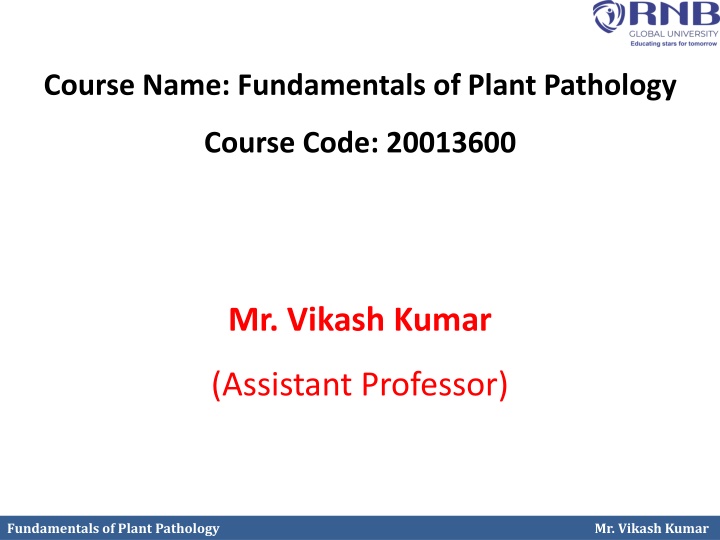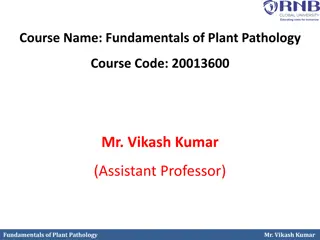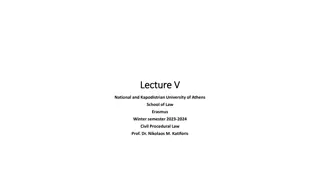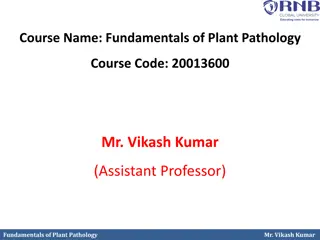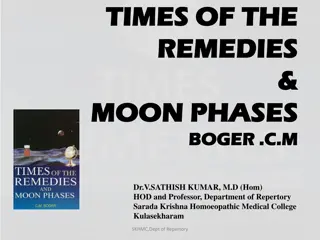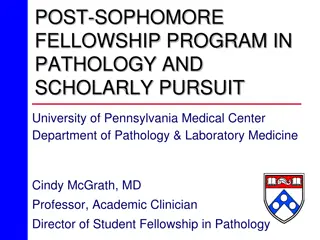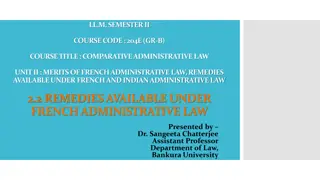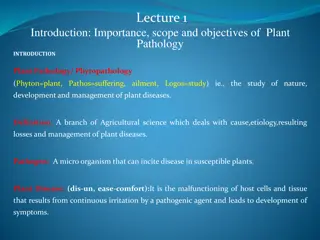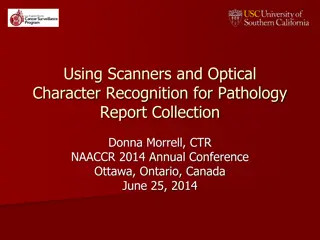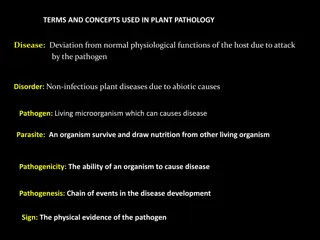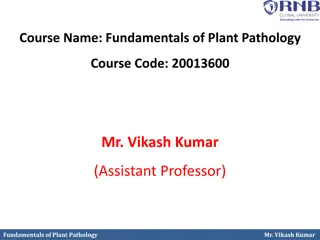Evolution of Plant Pathology: From Ancient Remedies to Modern Discoveries
Uncover the rich history of plant pathology, from ancient practices in Vraksha Ayurveda to modern breakthroughs by scientists like Anton de Bary and Alexander Fleming. Explore the development of mycology, key discoveries in disease management, and the impact of plant pathogens on historical events like the Great Bengal Famine. Join Mr. Vikash Kumar in understanding the fundamentals of plant pathology and the strategies for identifying, managing, and preventing plant diseases.
Download Presentation

Please find below an Image/Link to download the presentation.
The content on the website is provided AS IS for your information and personal use only. It may not be sold, licensed, or shared on other websites without obtaining consent from the author.If you encounter any issues during the download, it is possible that the publisher has removed the file from their server.
You are allowed to download the files provided on this website for personal or commercial use, subject to the condition that they are used lawfully. All files are the property of their respective owners.
The content on the website is provided AS IS for your information and personal use only. It may not be sold, licensed, or shared on other websites without obtaining consent from the author.
E N D
Presentation Transcript
Course Name: Fundamentals of Plant Pathology Course Code: 20013600 Mr. Vikash Kumar (Assistant Professor) Fundamentals of Plant Pathology Mr. Vikash Kumar
Course Objectives 1: Name and identify different Diseases, nature of pathogens and different strategies for management of plant diseases. 2: Outline concepts, nomenclature, classification and characters of pathogens 3: Apply different principles and methods for plant disease management. 4: Take a part in identification of diseases and marketing of relevant pesticides. 5: Conclude methods to diagnose and manage a wide range of plant diseases. Fundamentals of Plant Pathology Mr. Vikash Kumar
History of Plant Pathology Fundamentals of Plant Pathology Mr. Vikash Kumar
ANCIENT HISTORY Vraksha Ayurveda, a book written by Surapal in 11th century in Ancient India is the first book in which much light has been thrown on plant diseases. The Romans used to celebrate a festival called Robigalia to ward off rust about 700 BC to worship the, Rust God Robigo. Fundamentals of Plant Pathology Mr. Vikash Kumar
Mycology Dutch worker Anton von Leeuwenhoek developed the first microscope. Italian botanist P. A. Micheli proposed fungi comes from spores, considered he was a father of Mycology. E. M. Fries published Systema Mycologicum for naming of fungi, he was named as Linnaeus of Mycology. J. G. Kuhn published first textbook in Plant Pathology - The Diseases of Cultivated Crops, their Causes and their Control. Anton de Bary (Germany) worked out the life cycle of potato late blight and first to prove experimentally Phytophthora infestans is the cause of potato late blight. He proved that fungi are causes but not the results of diseases. He is the Father of Modern Plant Pathology. Fundamentals of Plant Pathology Mr. Vikash Kumar
Anton de Bary reported heteroecious nature of wheat stem rust. Brefeld discovered the methods of artificial culture of microorganisms. Robert Hartig published a textbook -Diseases of Trees. He is called as "Father of Forest Pathology". Pierre Marie Alexis Millardet accidentally discovered the Bordeaux mixture for the control of downy mildew of grapevine. Sir Alexander Fleming isolated the antibiotic, Penicillin from the fungus, Penicillium notatum. H. H. Flor developed gene-for-gene hypothesis in flax rust. Fundamentals of Plant Pathology Mr. Vikash Kumar
Great Bengal Famine due to Helminthosporium oryzae caused death of 2 million people in India(1943). B. B. Mundkur started Indian Phytopathological Society with its journal Indian Phytopathology. He has written a book Fungi and Plant Diseases in 1949, which is the second, book in plant pathology in India. J. E. Van der Plank found out vertical and horizontal types of resistance in crop plants. Van Schmeling and Marshall Kulka were the first to find out systemic fungicides (oxathiin compounds carboxin and oxycarboxin). Fundamentals of Plant Pathology Mr. Vikash Kumar
Bacteriology T. J. Burrill first time proved that fire blight of apple and pear was caused by a bacterium (now known as Erwinia amylovora). E.F.Smith (U.S.A) He was worked on the bacterial wilt of cucurbits and crown gall disease. He is also called as "Father of Phytobacteriology (Plant bacteriology) H. Stolp discovered bdellovibrios. D. W. Dye et al. introduced the pathovar in the taxonomy of plant pathogenic bacteria. Fundamentals of Plant Pathology Mr. Vikash Kumar
Plant Virology Adolf Mayer described a disease of tobacco called mosaic kranheit (tobacco mosaic). M.W. Beijerinck - He believed it to be contagium vivum fluidum (infectious living fluid). He was the first to use the term virus, which is the Latin word for poison. Iwanowaski Filtrate TMV juice extract from bacterial retaining filter. W. M. Stanley proved that viruses can be made as crystals. He got Nobel Prize in 1946. T. O. Diener discovered viroids, which only consist of nucleic acids. Smaller than viruses, caused potato spindle tuber disease Fundamentals of Plant Pathology Mr. Vikash Kumar
Phytoplasma Doi et al and Ishiie et al, the Japanese scientists found that mycoplasma like organisms (MLO) could be responsible for the disease of the yellows type. Spiroplasma Davies et al., observed that a motile, helical wall-less microorganism associated with corn stunt diseases, which could be cultured and characterized and they named it as spiroplasma. Fundamentals of Plant Pathology Mr. Vikash Kumar
Kochs postulates:- Three rules for experimental proof of the pathogenicity of an organism were presented in 1883 by the German bacteriologist, Robert Koch; a fourth was appended by E. F. Smith (1905). These rules of proof are often referred to as Koch's Postulates. 1. Assocition:- The suspected causal organism must be constantly associated with the disease. 2. 2. Isolation:- The suspected causal organism must be isolated from an infected plant and grown in pure culture. 3. 3. Inoculation:- When a healthy susceptible host is inoculated with the pathogen from pure culture, symptoms of the original disease must develop. 4. 4. Re-isolation:- The same pathogen must be re-isolated from plants infected under experimental conditions. Fundamentals of Plant Pathology Mr. Vikash Kumar
History of Plant Pathology in India K.R. Kirtikar was the first Indian scientist who collected and identified the fungi in the country. E.J. Bulter who is also known as the Father of Plant Pathology in India, initiated an exhaustive study of fungi and diseases caused by them in 1901 at Imperial Agricultural Research Institute at Pusa (Bihar). During his stay of 20 years in this country, he made a scientific study of mostly fungal plant diseases known in India at that time. The diseases studied by him for the first time included wilt of cotton and pigeon pea, different diseases of rice, toddy palm, sugarcane, potato and rusts of cereals. He wrote a monograph on Pythiaceous and Allied Fungi, and a classic text book, Fungi and Diseases in Plants in 1918. Fundamentals of Plant Pathology Mr. Vikash Kumar
J.F. Dastur (1886-1971), a colleague of Butler, was the first Indian Plant Pathologist who is credited with a detailed studies of fungi and diseases in plants. He studied the genus Phytophthora and diseases caused by it in castor and potato. He is internationally known for the establishment of Phytophthora parasitica from castor. G.S. Kulkarni published exhaustive information on downy mildew and smuts of sugarcane and pearl millet. B. B. Mundkur started Indian Phytopathological Society with its journal Indian Phytopathology. He has written a book Fungi and Plant Diseases in 1949, which is the second, book in plant pathology in India. He also authored a text book entitled, Fungi and Plant Diseases. Fundamentals of Plant Pathology Mr. Vikash Kumar
B.B. Mundkur started work on control of cotton wilt through varietal resistance. He was also responsible for the identification and classification of large number of Indian smut fungi. Dr. K.C. Mehta of Agra College, Agra investigated the life cycle of cereal rusts in India during the first half of 20th century. Dr. R. Prasada trained by Dr K.C. Mehta continued the work on rusts and added to the knowledge of linseed rust. Luthra and Sattar (1953) developed the solar heat treatment of wheat seed for the control of loose smut. SN Dasgupta carried out exhaustive studies on black tip of mango. Fundamentals of Plant Pathology Mr. Vikash Kumar
T.S. Sadasivan worked out the mechanism of wilting in cotton due to Fusarium oxysporum f. sp. vasinfectum. M.K. Patel, V.P. Bhide and G. Rangaswami pioneered the work on bacterial plant pathogens in India. M.J. Thirumalachar conducted exhaustive studies on rusts and smuts, and developed a number of antibiotics for controlling plant diseases in India. Fundamentals of Plant Pathology Mr. Vikash Kumar
Thank You Fundamentals of Plant Pathology Mr. Vikash Kumar
